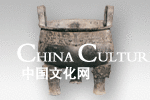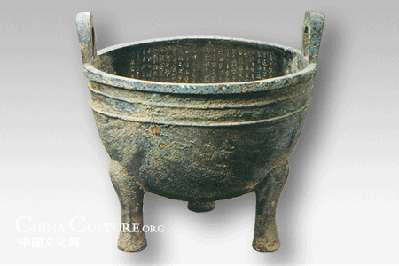As the seat of dozens of imperial capitals, Northwest China’s Shaanxi province is rich in cultural relics. The Shaanxi History Museum, located in Xi’an, capital of the province, is home to over 370,000 precious relics unearthed in Shaanxi over the past years. Its collections range from bronze wares to pottery figures, gold and silver wares and mural paintings from the Tang Dynasty (618-907) tombs. Among its precious collections, 18 pieces have been listed as national treasures.
1. Yu Ding (Bronze Tripod)

Age:Western Zhou Dynasty (about 1,100-771BC)
Height: 77 cm; Diameter: 56.5 cm
Unearthed in 1972 at Yangjia Village, Meixian County, Shaanxi
The vessel has three legs and patterns of auspicious animals carved on the surface.
This Ding was named after Yu, a Western Zhou official. 27 Chinese characters in four lines are inscribed inside the vessel, recording a king named Wang Jiang, who took back the fields he had bestowed to Shi Lu and gave them to Yu as awards. The inscription indicates the field ownership system at that time - that is, the king was the owner of all the fields under his jurisdiction and had the right to retake or bestow them to any of his subordinates.
2. Wushi Wei Ding (Bronze Tripod)

Age:Western Zhou Dynasty
Height: 36.3 cm; Diameter: 34.3 cm
Unearthed in 1975 at Dongjia Village, Qishan County, Shaanxi
The vessel has three pillar legs, with patterns of auspicious animals carved on the surface.
207 Chinese characters in 19 lines are inscribed inside the vessel, recording a land lawsuit in the Western Zhou dynasty. In the fifth year during the reign of Emperor Zhougongwang (922- 900BC), a man named Qiu Wei reported to the ruling officials that he had a land dispute with his neighbor Bangjunli. At last, it was judged that part of the land in dispute belonged to Qiu Wei. This inscription indicates the land system underwent changes in the middle of the Western Zhou Dynasty. At that time, some land belonged to individuals, rather than the king. However, the government still controlled land transfer among citizens.
This vessel is of great importance to research on the land system during the Western Zhou dynasty.
3. Duoyou Ding (Bronze Tripod)

Age:Western Zhou Dynasty
Height:51.5 cm Diameter of Mouth:50 cm
Unearthed in 1980 from Xiaquan Village, Chang’an County, Shaanxi Province
288 Chinese characters in 22 lines are inscribed inside the vessel, recording the Zhou army led by General Duoyou, who defeated Yan Yun, an ethnic group in the northern part of China. During the reign of Emperor Zhouliwang, General Duoyou was ordered to fight against the ethnic minority Yan Yun who launched a war against the Zhou dynasty. According to the inscription, the Zhou army defeated the enemy in four battles, killing 350 and capturing 23 Yan Yun soldiers and 127 war carriages. Emperor Zhouliwang had the Duoyou Ding made to commemorate the general’s extraordinary military achievements.
This vessel is of great importance in researching the war history of Western Zhou and neighboring ethnic groups.